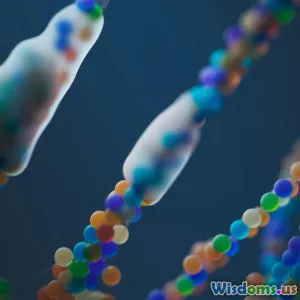
Personal Experience Using Gene Editing Tools in the Lab
8 min read An insider's detailed journey using gene editing tools in the lab, revealing techniques, challenges, and scientific breakthroughs. (0 Reviews)
Personal Experience Using Gene Editing Tools in the Lab
Introduction: Unlocking the Code of Life
Stepping into a laboratory where gene editing tools are routinely employed is like entering a cutting-edge science fiction novel brought to life. The ability to precisely modify DNA sequences has revolutionized biology and medicine, opening unparalleled opportunities to tackle genetic diseases, enhance crops, and understand life itself from a molecular lens. In my journey working with gene editing tools—primarily CRISPR-Cas9—I’ve encountered both exhilarating breakthroughs and intricate challenges. This article explores the practical facets of gene editing from my personal perspective, offering insight into its transformative power and what it truly takes to harness these precise molecular scissors.
Understanding the Fundamentals of Gene Editing
Before delving into my experience, it’s vital to understand the basics of what gene editing tools do. At their core, these tools enable scientists to add, remove, or alter genetic material at specific locations in the genome. Among several methods, CRISPR-Cas9 dominates the field due to its simplicity, efficiency, and versatility.
Why CRISPR-Cas9?
CRISPR technology utilizes a guide RNA to direct the Cas9 enzyme to a targeted DNA sequence, where Cas9 introduces a double-stranded break. The cell’s own DNA repair mechanisms then kick in—either non-homologous end joining (NHEJ) or homology-directed repair (HDR)—allowing scientists to deactivate genes or swap in new genetic information.
When I first started using CRISPR in the lab, it was fascinating to witness this elegantly programmed molecular system mimic natural bacterial immune defense, adapted to our precise scientific needs.
Firsthand Experience: Navigating the Lab Workflow
Designing the Guide RNA
One of the most critical steps is designing an effective guide RNA (gRNA). Early in my projects targeting a gene linked to metabolic disorders, I used bioinformatics platforms like Benchling and CHOPCHOP to identify target sites that minimized off-target effects. Despite computational assistance, fine-tuning gRNA often required designing multiple candidates and running pilot experiments.
For example, one gRNA with perfect sequence complementarity unexpectedly reduced editing efficiency due to chromatin accessibility constraints in human cell lines. This taught me that computational prediction must be paired with empirical validation.
Setting Up the Experiment
From culturing HEK293 cells to preparing plasmid constructs encoding Cas9 and gRNA, the process demanded careful optimization. Variables such as transfection reagent choice, DNA amounts, and cell confluency significantly influenced editing success. Initially, inconsistent transfection efficiency led to low gene editing rates, prompting me to switch reagents and optimize cell density.
Validating Gene Editing Outcomes
Once cells were transfected, confirming the gene edits was crucial. Techniques like T7 endonuclease I assay and Sanger sequencing became my routine tools. For example, after editing a gene knockout in fibroblasts, I performed PCR amplification of the target region, followed by the T7E1 assay to detect DNA mismatches formed by indels.
In several instances, I combined sequencing with functional assays, such as enzymatic activity measurements, to verify that genetic edits translated to expected cellular phenotypes. Getting to this validation step underscored the importance of patience and precision in lab work.
Challenges and Lessons Learned
Off-Target Effects and Their Mitigation
One of the major concerns with gene editing is off-target cleavage, which can create unintended mutations. Early in my work, I saw unanticipated genome modifications caused by imperfect gRNA targeting. To mitigate this, my lab adopted high-fidelity Cas9 variants and truncated gRNAs, which literature and empirical data showed reduce off-target activity significantly.
Ethical Reflections
Working intimately with gene editing technologies sparked deep reflections on the ethical dimensions. Editing somatic cells for disease treatment is vastly different from germline editing, which could affect future generations. Discussions with my mentors and colleagues emphasized responsible use, regulatory considerations, and ongoing societal dialogue about gene editing boundaries.
Troubleshooting Experimental Setbacks
Not every experiment was a success. There were times when poor cell viability, plasmid inefficiency, or reagent degradation required tweaking protocols and sometimes complete overhauls of methods. These setbacks were learning opportunities highlighting the importance of meticulous technique and documentation.
The Broader Impact and Future Outlook
My personal experience, while focused on laboratory benchwork, also connected me to larger scientific and medical communities. Gene editing has led to clinical trials offering hope to patients with sickle cell anemia and inherited blindness, reminding us that precise genome engineering is much more than academic—it’s potentially life-changing.
Looking forward, innovations such as base editing, prime editing, and delivery advancements promise to increase precision and broaden applicability. The pace at which these tools evolve necessitates lifelong learning and adaptation for scientists like me committed to exploring genomic frontiers.
Conclusion: Empowered by Precision and Perspective
Engaging hands-on with gene editing tools has been one of the most intellectually fulfilling and challenging experiences of my scientific career. It requires blending bioinformatics, molecular biology, and critical thinking to navigate complex biological systems. Yet, the thrill of editing a gene with high precision and witnessing biological changes reaffirms why gene editing stands at the pinnacle of modern biotechnology.
For those curious about joining this frontier, my advice is clear: embrace rigorous study, be fearless in troubleshooting, and consider carefully the ethical weight of your work. In mastering these tools, we don’t just rearrange DNA letters—we unlock the potential to transform lives.
Author’s note: The personal insights shared here stem from my time working in a biomedical research lab focused on genetic therapies and functional genomics.
Rate the Post
User Reviews
Popular Posts



















